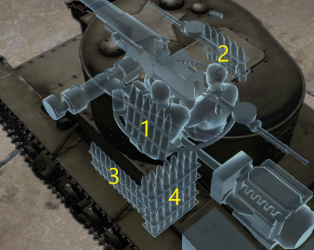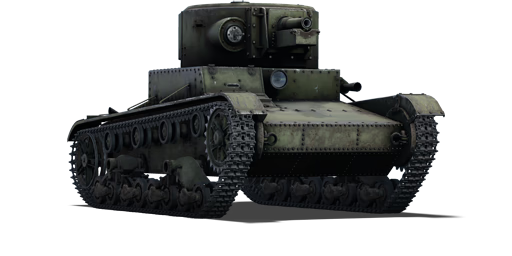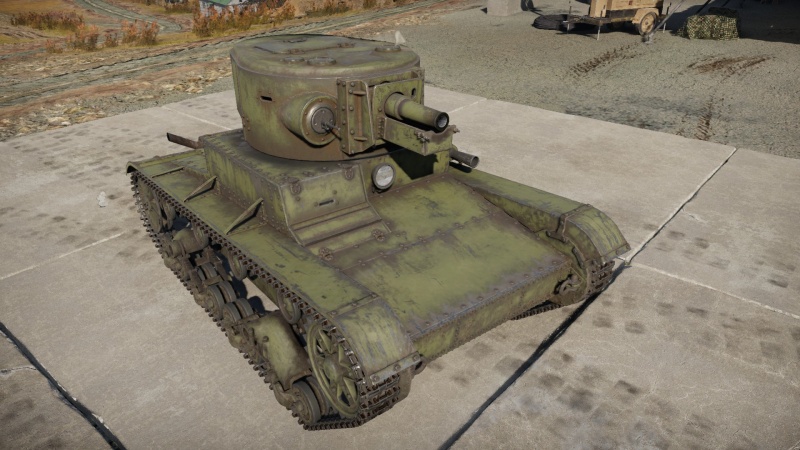T-26-4
| This page is about the Soviet light tank T-26-4. For other uses, see T-26 (Family). |
Contents
Description
The T-26-4 is a rank I Soviet light tank with a battle rating of 1.0 (AB/RB/SB). It was introduced in Update 1.51 "Cold Steel".
The T-26-4 is a rather unusual tank, combining average speed, thin armour and a large gun. It uses the same hull as T-26 and an enlarged turret not dissimilar to the T-28's main turret, able to mount the 76mm KT-28 howitzer.
General info
Survivability and armour
The armour of the T-26-4 is thin, thus making the vehicle's survivability low. Armour is nearly flat on all sides, so it is recommended to not expose yourself to enemy fire. The crew are not lined up behind each other from the front, meaning that enemies using shells without HE filler may have to take up to 2-3 shots before knocking out all of your crew. Beware of heavy machine guns (common on American tanks) and autocannons (common on German and Italian tanks), since they will be able to both penetrate your hull armor and shred your crew/modules. Despite these concerns, a skilled tanker can use the small profile of the tank and its 76 mm APHEBC cannon and try to destroy light and medium targets before they shoot back.
Armour type:
- Rolled homogeneous armour
| Armour | Front | Sides | Rear | Roof |
|---|---|---|---|---|
| Hull | 15 mm (18°) Driver's plate 15 mm (1°) Front plate 7 mm (64-80°) Front glacis 15 mm (6-52°) Lower glacis |
15 mm (0-1°) | 15 mm (1-31°) Top 15 mm (11°) Bottom |
10 mm Hull 6 mm Rear |
| Turret | 15 mm (0-3°) Turret front 15 mm (6-7°) Gun mantlet |
15 mm (0-1°) | 15 mm (1°) | 10 mm |
Notes:
- Suspension wheel is 10 mm thick while tracks are 15 mm thick.
- Belly armour is 6 mm thick
Mobility
| Game Mode | Max Speed (km/h) | Weight (tons) | Engine power (horsepower) | Power-to-weight ratio (hp/ton) | |||
|---|---|---|---|---|---|---|---|
| Forward | Reverse | Stock | Upgraded | Stock | Upgraded | ||
| Arcade | 34 | 4 | 11 | 141 | 174 | 12.82 | 15.82 |
| Realistic | 31 | 4 | 80 | 91 | 7.27 | 8.27 | |
Modifications and economy
As usual, Parts and FPE are the most important modules to research. After that, mobility upgrades will be very useful, since the tank has below-average mobility when stock. Even more important, perhaps, are the Horizontal Drive and Elevation Mechanism modifications. These will improve the vehicle's poor turret traverse speeds. Finally, the BR-350A shell has more penetration and contains more explosive filler than the stock shrapnel shell. If you are having difficulties with penetrating or destroying enemy targets using the shrapnel shell, this modification will prove invaluable.
Armaments
Main armament
| 76 mm KT-28 | Turret rotation speed (°/s) | Reloading rate (seconds) | |||||||||||
|---|---|---|---|---|---|---|---|---|---|---|---|---|---|
| Mode | Capacity | Vertical | Horizontal | Stabilizer | Stock | Upgraded | Full | Expert | Aced | Stock | Full | Expert | Aced |
| Arcade | 50 | -5°/+21° | ±180° | N/A | 15.2 | 21.1 | 25.6 | 28.3 | 30.1 | 5.20 | 4.60 | 4.24 | 4.00 |
| Realistic | 9.5 | 11.2 | 13.6 | 15.0 | 16.0 | ||||||||
Ammunition
| Penetration statistics | |||||||
|---|---|---|---|---|---|---|---|
| Ammunition | Type of warhead |
Penetration @ 0° Angle of Attack (mm) | |||||
| 10 m | 100 m | 500 m | 1,000 m | 1,500 m | 2,000 m | ||
| BR-350A (MD-5 fuze) | APHEBC | 37 | 37 | 33 | 30 | 27 | 24 |
| OF-350M | HE | 11 | 11 | 11 | 11 | 11 | 11 |
| Sh-353 | Shrapnel | 27 | 25 | 21 | 19 | 16 | 12 |
| Shell details | |||||||||
|---|---|---|---|---|---|---|---|---|---|
| Ammunition | Type of warhead |
Velocity (m/s) |
Projectile Mass (kg) |
Fuse delay (m) |
Fuse sensitivity (mm) |
Explosive Mass (TNT equivalent) (g) |
Ricochet | ||
| 0% | 50% | 100% | |||||||
| BR-350A (MD-5 fuze) | APHEBC | 370 | 6.3 | 1.2 | 14 | 155 | 48° | 63° | 71° |
| OF-350M | HE | 387 | 6.2 | 0.05 | 0.1 | 710 | 79° | 80° | 81° |
| Sh-353 | Shrapnel | 381 | 6.2 | 0.5 | 8 | 85 | 62° | 69° | 73° |
Ammo racks

| Full ammo |
1st rack empty |
2nd rack empty |
3rd rack empty |
4th rack empty |
Visual discrepancy |
|---|---|---|---|---|---|
| 50 | 45 (+5) | 39 (+11) | 29 (+21) | 1 (+49) | No |
Note:
- Turret empty: 39 (+11) shells.
Machine guns
| 7.62 mm DT | ||||
|---|---|---|---|---|
| Mount | Capacity (Belt) | Fire rate | Vertical | Horizontal |
| Coaxial | 1,890 (63) | 600 | N/A | N/A |
| Rear | 1,890 (63) | 600 | ±15° | ±15° |
The small calibre of the DT machine guns makes them largely ineffective against all armoured vehicles except for ones with an open crew compartment like Tank Destroyers and SPAAs. They still can be used to ping targets as a rangefinding help or to mow down minor obstacles blocking your line of sight. The clip capacity is quite poor as they rely on magazines of 63 bullets instead of belts like similar machine guns from other nations.
Usage in battles
All three of this tank's shells have a very low muzzle velocity, which means that engaging at long range, or even at medium range, is very difficult. Instead, the T-26-4 does the most damage up close, where aiming is easier. Fortunately, most engagements at rank I are fought at near point-blank range.
The lack of armour is really something to be kept in mind, even some tank machine guns like the 12.7 mm M2HB and 13.2 mm Breda Model 31 will be able to go through your thickest pieces of armour (15mm). Because of this, it is recommended to try your best to avoid enemy vehicles getting the first shot. Driving under cover is advisable to avoid being spotted.
This vehicle sometimes has trouble actually getting in to those close engagements. It has quite poor mobility compared to its peers (for example, the BT-5), and therefore can miss out on the first stages of a battle. The slow speed also means that long flanking manoeuvres may be difficult to pull off. Therefore, this tank finds success as an ambusher or as a direct supporter of friendly vehicles. Team play is vital to being successful in this vehicle.
This vehicle has quite a high-calibre gun for this rank, but the stock shrapnel shell has poor penetration (despite its high post-penetration damage). It if often unable to penetrate enemy tanks frontally, and against some vehicles, such as the Pz.III E, it can't even penetrate the side armour. This makes flanking even more important for this vehicle--otherwise, the player will often find themselves unable to deal damage to the enemy. Once the APHEBC BR-350A shell is researched, the gun will be able to penetrate most tanks at this battle rating through their frontal armour, and finding side-shots will become less important.
If possible, fire should be concentrated on lightly armoured vehicles--It's dangerous to go alone, so it is recommended to stay near teammates. Otherwise, you risk an encounter with a tank that you won't be able to penetrate.
Pros and cons
Pros:
- Gun can easily destroy any tank it meets with a single shot
- Manoeuvrability is quite good, although somewhat limited by its low top speed (30 km/h)
- Decent reload speed
Cons:
- Low survivability due to the thin, nearly unangled armor
- Three crew members packed tightly together significantly reduces survivability
- Poor overall mobility; low top speed, very low reverse speed, slow hull traverse, and difficulty in climbing steep slopes
- Average turret rotation combined with the sluggish hull traverse prevents it from responding to flanks quickly
- Average -5° gun depression limits its potential in hilly terrains
- Some ammo is stored inside the turret which tends to explode when hit
History
The T-26-4 light tank is a fire support variant of the T-26 light tank. Instead of mounting a 45 mm cannon as its main armament, the T-26-4 mounts the 76.2 mm KT tank gun and is intended to fill the role of an artillery tank. The turret looks similar to the T-28 medium tank, if not the same.
The T-26-4 design was tested in October 1933 after five were built. It was in this test that the 76.2 mm KT cannon was chosen to arm it instead of the more powerful and innovative 76.2 mm PS-3 cannon. A production of 50 of these tanks was scheduled in 1935, but an incident on September 19, 1934, with a shell case destruction caused the military to cancel the T-26-4. The T-26-4 turret was then used on the BT-7A light tank intended for the same role.
In-game description
An experimental version of a fire support light tank. Even before the T-26 began serial production the authorities of the Red Army raised the question of enhancing the tank's weaponry and building a fire-support tank. The process of designing a turret for the 76 mm cannon began in February, 1932. An experimental model of the T-26-4 was built in November, 1932. After it underwent successful testing in 1933 the factory received an order to build a base batch of five vehicles. The new vehicles entered military testing in 1934. After testing was complete an experimental batch of 50 vehicles was planned. However, during a drill near Leningrad an incident occurred, after which the decision was made to cancel the production of the experimental batch. All further work on this vehicle was cancelled.
Media
- Skins
- Videos
See also
- Vehicles equipped with the same chassis
- Vehicles equipped with the same gun
External links
| USSR light tanks | |
|---|---|
| T-26 | T-26 · T-26 (1st Gv.T.Br.) · T-26-4 · T-26E |
| BT | BT-5 · RBT-5 · BT-7 · BT-7 TD · BT-7M · BT-7A (F-32) |
| T-50 | T-126 · T-50 |
| T-70 | T-70 · T-80 |
| PT-76 | PT-76B · PT-76-57 · Object 906 |
| BMP | BMP-1 · BMP-2 · BMP-2M · BMP-3 |
| BMD | BMD-4 |
| 2S25 | 2S25 · 2S25M |
| Wheeled | BA-11 · BTR-80A |
| Other | T-60 · Object 685 · 2S38 |
| China | ▂Type 62 |





